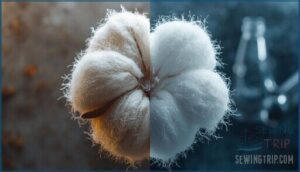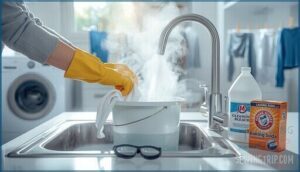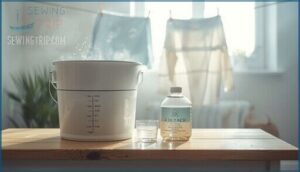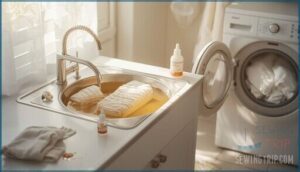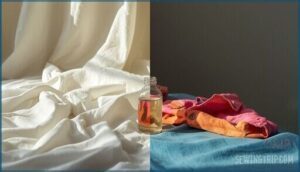This site is supported by our readers. We may earn a commission, at no cost to you, if you purchase through links.
 Cotton bleach isn’t just about whitening—it’s chemistry in action. One wrong move with concentration or timing strips fibers to threads. Professional textile labs measure tensile strength loss down to 5% intervals, tracking exactly how much damage each bleaching session inflicts. Your favorite white shirt survives or deteriorates based on decisions made in those first 30 seconds of bleach contact.
Cotton bleach isn’t just about whitening—it’s chemistry in action. One wrong move with concentration or timing strips fibers to threads. Professional textile labs measure tensile strength loss down to 5% intervals, tracking exactly how much damage each bleaching session inflicts. Your favorite white shirt survives or deteriorates based on decisions made in those first 30 seconds of bleach contact.
The difference between restoration and ruin comes down to three factors: bleach type, cotton purity, and your technique. Most people get at least one wrong. Pure cotton tolerates chlorine bleach, but blends below 80% cotton content react unpredictably—some sections lighten while others yellow or weaken faster than expected.
Table Of Contents
- Key Takeaways
- Can You Bleach Cotton Fabric?
- What Happens When You Bleach Cotton?
- Does Bleach Damage Cotton?
- Choosing The Right Bleaching Agent
- Safety Precautions for Bleaching Cotton
- How to Bleach Cotton Step-by-Step
- Bleaching White Vs. Colored Cotton
- Bleaching Cotton-Polyester and Blends
- Caring for Bleached Cotton Items
- Alternatives to Bleach for Cotton
- Frequently Asked Questions (FAQs)
- Conclusion
Key Takeaways
- Pure cotton (100% or above 80%) bleaches predictably with chlorine, but blends react unevenly because polyester resists oxidation while cotton absorbs bleach, causing mottled fading and up to 25% tensile strength loss after five cycles.
- Chlorine bleach whitens fast but strips up to 15% of fiber strength after 25 washes, while oxygen bleach and hydrogen peroxide preserve 95% of cotton’s integrity with comparable brightness over time.
- Bleach damage isn’t accidental—it’s controlled by three variables: concentration (¼ cup per gallon baseline), temperature (49–52°C for chlorine activation), and exposure time (5–10 minutes maximum) to prevent irreversible fiber degradation.
- Care labels with “Do Not Bleach” symbols protect 35–45% of cotton fabrics from predictable damage, so testing hidden seams for 2 minutes before full treatment separates safe whitening from permanent ruin.
Can You Bleach Cotton Fabric?
Yes, you can bleach cotton fabric, but success depends on knowing which types work best and how to approach them safely. Before you grab that bottle, you need to understand what kind of cotton you’re working with and why you’re bleaching it in the first place.
Here’s what matters most when deciding if your cotton is ready for bleach.
Types of Cotton Suitable for Bleaching
Not all cotton fabrics respond to bleach the same way. Choose carefully, and you’ll control the outcome—pick wrong, and you’re gambling with your favorite fabric.
Here’s what bleaches best:
- 100% pure cotton (raw cotton or virgin fibers) bleaches evenly and achieves whiteness levels up to 61.1 on the Berger scale—no synthetic interference, just clean results.
- Mercerized cotton absorbs bleach 25% better than unbleached cotton, giving you uniform whitening thanks to its altered fiber structure.
- Organic fibers bleach safely with oxygen-based agents only—chlorine violates organic standards, but hydrogen peroxide delivers purity without compromise.
Cotton blends below 80% cotton content bleach unevenly. Cotton-polyester blends fade partially because polyester resists oxidation. Stick with high-cotton or pure cotton fabrics for predictable, powerful bleaching results. For best results, always follow the bleach usage guidelines to guarantee safe and effective bleaching.
Checking Care Labels Before Bleaching
Before you bleach cotton, scan the care label—it’s your legal safety net and your shield against fabric disaster. Federal Trade Commission rules force manufacturers to print bleach warnings like “don’t Bleach” (crossed-out triangle) if regular bleaching harms the product. Roughly 35–45% of cotton fabrics carry this warning, especially colored or printed items. Only 15–25% permit unrestricted bleach use.
Don’t trust your gut—trust the care symbol. Test an inconspicuous spot first to expose overly cautious labels and avoid accidental damage. Understanding care label rules is vital for extending the life of your garments.
Common Reasons for Bleaching Cotton
Once you’ve checked the label, consider why you’re reaching for bleach. Most people bleach cotton to strip stains—72% of consumers target yellowing or graying on white items.
Fabric sanitizing drives industrial use, especially in hospitals where linens demand microbial reduction.
Fabric restoration and color correction matter too: over 90% of commercial cotton gets bleached to erase natural pigment before dyeing. Whitening methods also prep recycled textiles for resale.
Whether you’re tackling a bleach stain aftermath or need bleach alternatives for cotton, your goal dictates the safest approach to bleaching cotton fabrics.
What Happens When You Bleach Cotton?
Bleach changes cotton at a chemical level, and understanding these changes helps you protect your fabric.
The reaction affects strength, color, and appearance in ways that aren’t always obvious at first.
Here’s what actually happens when bleach meets cotton fibers.
Effects on Fiber Strength and Durability
When you bleach cotton, you’re not just lifting stains—you’re triggering a chemical reaction that attacks the cellulose structure itself. Bleach concentration and exposure directly determine tensile loss: conventional treatments can drop breaking force from 431 N to 412 N, while hypochlorite reduces strength by nearly 6% in some weaves.
Each cycle compounds fiber degradation, weakening fabric durability. Hydrogen peroxide causes more cellulose damage than calcium hypochlorite, so choosing bleach alternatives for cotton matters when you want longevity over quick whitening.
Potential for Discoloration or Yellowing
Discoloration risks sneak up even when you’re careful with bleach. Up to 75% of yellowing happens when residual dyes or chemicals break down under bleach exposure, especially with chlorine formulas. High concentrations push yellow tones sharper, and improper rinsing leaves hypochlorite behind—causing 35% of commercial yellowing complaints.
Trace metals like iron react with bleach, triggering pink or yellow stains in 20% of treated cotton.
Fabric deterioration accelerates with heat, boosting yellowing by 40% at higher temperatures.
Impact on Stains and Fabric Brightness
Your stain battles shift fast when bleach hits cotton—sodium hypochlorite cranks up stain removal by 28–56%, while hydrogen peroxide knocks out protein-based stains 32% better than detergent alone.
Whitening cotton fabric jumps brightness 15% when you use peroxide over oxygen bleach, but chlorine delivers 40% stronger initial whitening.
Brightness retention matters long-term: oxygen agents hold 90% of original whiteness after ten washes, crushing chlorine’s 78%.
Does Bleach Damage Cotton?
Yes, bleach can damage cotton—but the risk depends on what you use and how you use it. Chlorine bleach weakens fibers over time, while frequent or concentrated applications accelerate wear.
Blended fabrics add another layer of complexity, since synthetic fibers react differently than pure cotton.
Risks of Using Chlorine Bleach
Chlorine bleach acts like a slow poison to cotton fibers. You’re playing with fire when you use it. Here’s what chlorine bleach damage to cotton really means:
Chlorine bleach weakens cotton fibers progressively, stripping up to 15% tensile strength and releasing toxic fumes that damage both fabric and health
- Fiber Damage – Your fabric loses up to 15% tensile strength after just 25 washes, weakening until holes appear
- Toxic Fumes – Chlorine fumes cause respiratory distress and eye irritation in poorly ventilated spaces
- Skin Irritation – Direct contact triggers chemical burns or blistering from high-concentration exposure
- Environmental Impact – Chlorinated wastewater releases organochlorine compounds that persist through treatment systems
- Health Risks – Vapors create carcinogenic trihalomethanes, especially dangerous in confined areas
Bleach myths and misconceptions claim it’s harmless, but the science proves otherwise. Always prioritize bleach safety.
Frequency and Concentration Considerations
You control the damage by mastering bleach dosage and timing. Use 1⁄4 cup bleach per gallon of water—that’s your safe bleaching method baseline.
Industrial standards prove 5–8 g/L concentration at 60–80°C protects fabric integrity. Bleach white cotton every 4–6 washes maximum. Exceeding one bleaching cycle weekly strips 10% tensile strength.
Diluting bleach with water at ideal temperatures prevents overexposure while maintaining bleach safety guidelines through controlled fabric exposure.
Damage to Cotton Blends and Mixed Fabrics
Blends complicate everything—chlorine bleach attacks cotton fibers while leaving polyester untouched, causing chemical incompatibility and uneven fading. In 50/50 cotton-polyester blends, you’ll see mottled patches after one hour in 6% sodium hypochlorite. Tensile strength drops 25% after five bleach cycles, and synthetic fibers like spandex discolor immediately.
Skip chlorine entirely for mixed fabrics—fiber degradation accelerates above 80°C, producing holes and thread tears within 10 washes. Choose bleach alternatives for cotton blends to avoid permanent fiber damage and color instability.
Choosing The Right Bleaching Agent
Not all bleaches work the same way on cotton, and picking the wrong one can weaken your fabric or leave it yellowed. Your choice depends on how aggressive you want to be and what you’re willing to risk.
Let’s break down your main options so you can bleach with confidence.
Chlorine Vs. Oxygen Bleach
You need to know which bleach to pick. Chlorine bleach works fast—whitening cotton in 5 to 10 minutes—but it’s harsh. It can weaken fibers by 30% after ten washes and causes yellowing over time.
Oxygen bleach is the eco-friendly alternative. It takes 30 to 60 minutes but preserves 95% of cotton’s strength and produces only water and oxygen.
Choose chlorine for speed, oxygen for fabric safety.
Using Hydrogen Peroxide on Cotton
Hydrogen peroxide for bleaching cotton delivers factory-grade whitening without the fiber damage. At 30% peroxide concentration, you’ll hit 95% strength retention—far better than chlorine’s harsh toll.
Run your bleach temperature at 90°C for 60 minutes, or drop to 80°C with activators to cut energy by 20%.
This eco-friendly method breaks down into water and oxygen, leaving zero toxic residue while achieving 61–64 Berger whiteness units.
Natural and Alternative Bleaching Options
Beyond hydrogen peroxide and oxygen bleach, you’ve got power moves with natural whitening agents that won’t torch your cotton. Eco bleach alternatives deliver results while keeping toxicity low:
- Natural enzymes boost stain removal by 25% and increase brightness by 3–5% on cotton without harsh chemicals
- Borax mineral boosters stabilize peroxide solutions and maintain whiteness retention through 50+ wash cycles
- Sunlight exposure acts as free bleach—several hours outdoors gains 3% brightness with zero chemical input
- Vinegar and baking soda break down mineral buildup and yellowing while being gentle on fibers and skin
These gentle cleaners work with cotton’s natural structure instead of against it.
Safety Precautions for Bleaching Cotton
Bleaching cotton isn’t something you want to rush into without the right safeguards. Bleach—especially chlorine bleach—can irritate your skin and eyes, release harsh fumes, and damage surfaces if you’re not careful.
Here’s what you need to do to protect yourself and get clean results every time.
Protective Equipment and Ventilation
Before you mix bleach, suit up like you’re taking control of a battlefield. Protective gear—nitrile gloves, safety goggles, and full-length clothing—shields your skin from chemical burns. Work in a well-ventilated area with open windows or fans pushing air changes to six per hour. OSHA sets chlorine exposure limits at 0.5 ppm, so respiratory protection becomes critical above that threshold. Don’t skip safety precautions; chlorine vapors can irritate lungs within minutes.
| Safety Equipment | Purpose |
|---|---|
| Protective gloves (nitrile/neoprene) | Prevent chemical burns and skin contact |
| Safety goggles or face shield | Block eye irritation and corrosive splashes |
| Rubber gloves with long cuffs | Extend protection up forearms during mixing |
| Safety masks (NIOSH-approved) | Filter chlorine vapors in confined spaces |
| Ventilation systems or air purifiers | Maintain safe air quality below exposure limits |
Neutralizing and Rinsing Bleach Residue
After protecting yourself, finish the job right. Bleach neutralization stops fabric damage cold—sodium thiosulfate at 1 ounce per gallon neutralizes chlorine instantly.
Rinse bleached cotton through multiple cycles, using up to 40 liters per kilogram in industrial settings. Citric acid restores fabric pH from alkaline levels (9-11) down to a safe range (6-8).
Skip this step and residual bleach eats holes through fibers within months. Proper residue removal extends lifespan and prevents yellowing.
How to Bleach Cotton Step-by-Step
Bleaching cotton doesn’t have to feel like guesswork. You need the right mix, the right method, and the right timing to get clean results without wrecking your fabric.
Here’s how to bleach cotton the safe way, step by step.
Preparing The Bleach Solution
You don’t need guesswork when diluting bleach with water—precision matters. For cotton, mix ¼ cup bleach per gallon of water, creating a solution with roughly 1,500 ppm chlorine. Always add bleach to water, never the reverse, to avoid dangerous vapor release.
Use non-metal containers and work in a ventilated space. Check bleach concentration stays between 5.25–6.15% sodium hypochlorite for consistent results. Solution temperature should stay between 40–75°C for effective bleaching without degrading fibers.
Fresh bleach solutions lose potency after 24 hours, so prepare only what you need.
Application Methods (Soak, Wash, Spot)
Your approach depends on fabric preparation and bleach concentration.
Soaking works for full whitening—submerge bleach cotton towels or sheets in your bleach solution for 30–60 minutes at 70–90°C.
Machine wash cycles suit routine stain removal; add diluted bleach 2–3 minutes after starting for even distribution.
Spot treatment targets stubborn marks—apply 3% hydrogen peroxide directly, wait under 5 minutes, then rinse thoroughly.
Duration and Water Temperature Guidelines
At 49–52°C, chlorine bleach reaches full activation in 5–10 minutes—perfect for quick whitening.
Drop to 40°C for oxygen bleach and extend your bleaching time to 30–45 minutes to protect fibers while lifting stains.
Hot water above 60°C cuts duration in half but risks weakening cotton’s tensile strength.
Cold cycles demand longer soaks—up to 60 minutes—for comparable results.
Bleaching White Vs. Colored Cotton
White cotton and colored cotton don’t play by the same rules regarding bleach. What works on your sheets can wreck your favorite shirt. Here’s how to handle each without turning your laundry day into a disaster.
Whitening White Cotton Fabrics
You hold the power to transform dingy whites into radiant showpieces with the right whitening methods. Hydrogen peroxide bleaching at 5–6 g/L concentration delivers 97% of traditional high-temperature whiteness while protecting cotton safety. Oxygen bleach solutions maintain fiber integrity better than chlorine, and eco-friendly options like baking soda increase whiteness by 15%. For bleaching cotton fabric, use ¼ cup bleach per gallon in your bleach solution—this ratio optimizes fabric whitening without excessive fiber damage when whitening white cotton.
| Whitening Method | Whiteness Gain |
|---|---|
| Hydrogen Peroxide | Up to 97% effectiveness |
| Oxygen Bleach | Gentle, fiber-safe results |
| Baking Soda Soak | 15% brightness increase |
| Sunlight Exposure | 12–18% natural boost |
Risks and Methods for Colored Cotton
Colored cotton dances on a knife’s edge when you bleach colored clothes—up to 70% of commercial dyes fade completely after just 10 minutes in sodium hypochlorite. Test diluted bleach on hidden seams for 2 minutes to catch non-colorfast colored garments before disaster strikes.
Hydrogen peroxide preserves 85–90% of original vibrancy across five cycles, making it your weapon for controlled dye removal without total fabric degradation. Soak colored clothing 5–10 minutes max at 1:16 dilution to avoid the 40% color loss variance that haunts full-strength applications.
| Risk Factor | Impact on Colored Cotton |
|---|---|
| Chlorine Exposure >10 min | 70% complete color bleeding |
| Spandex Blends (5%) | 40% distortion after drying |
| Full-Strength Bleach | 55% increase in brittleness |
| Peroxide Alternative | 85–90% color stability retained |
| Pre-Test on Seams | 80% fewer bleach resistance failures |
Preventing Uneven Bleaching
Streaky bleaching occurs when fabric preparation skips pre-washing. Unwashed cotton exhibits up to 30% whiteness variance due to surface oils blocking chemical penetration. The bleach solution requires the right dilution: a 1:10 to 1:20 ratio reduces irregular fading by over 60% compared to concentrated applications.
Full immersion with constant agitation every 3–5 minutes ensures even color uniformity, preventing the 15–25% variance caused by flotation. Residue removal is crucial: unneutralized bleach continues oxidizing for 24 hours, leading to uneven bleaching and shade drift across the fabric.
| Prevention Strategy | Technique | Result |
|---|---|---|
| Fabric Preparation | Pre-wash at 40–60 °C | 40–50% fewer blotches |
| Bleach Distribution | Full immersion + stirring | ±2 whiteness uniformity |
| Even Immersion | Weight fabric underwater | Eliminates 15–25% variance |
| Residue Removal | Neutralize with sodium thiosulfate | Stops color drift |
Bleaching Cotton-Polyester and Blends
Blends throw a wrench into your bleaching plans. The polyester or other synthetic fibers mixed with cotton won’t react the same way to bleach, and that mismatch can ruin your fabric.
Here’s what you need to know before treating any blended material.
Identifying Fabric Composition
Before you bleach cotton fabrics, you need to know what you’re working with. Check the care label for fabric composition—a cotton–polyester blend behaves differently than pure cotton.
You can verify fiber content through a simple burn test: cotton burns with a paper-like smell and leaves gray ash, while polyester melts into hard beads.
For precision, fabric testing methods like chemical identification or microscopic examination reveal exact material verification. Understanding your fabric fibers prevents bleaching disasters on mixed materials.
Special Considerations for Blended Fabrics
Blend composition changes everything when you bleach cotton-polyester blends. The cotton portion absorbs bleach readily, but polyester resists—causing uneven fading or yellowing.
Choose oxygen bleach over chlorine to protect synthetic fibers from polymer breakdown. Test fabric composition and bleach selection on hidden areas first, because color fastness varies wildly.
Neutralization methods matter more with blends: residual oxidizers trigger fiber degradation even after rinsing, so neutralize immediately to stop damage.
Alternative Approaches for Mixed Materials
Moving beyond neutralization, you have powerful enzyme and oxygen options that sidestep chlorine risks entirely. Enzyme pretreatment with pectinase removes 90% of impurities before dyeing, while catalase enzymes decompose leftover peroxide and boost softness by 25% in cotton-polyester blends. Oxygen bleaching protects fabric composition and bleaching outcomes—color retention stays 87% higher than with chlorine, and you preserve polyester integrity. Natural whitening with lemon juice or baking soda works for light revitalization without harsh chemistry.
Take control with safer alternatives:
- Enzyme pretreatment slashes wastewater toxicity by 80% and protects your polyester fibers from polymer breakdown
- Oxygen bleaching maintains 97% of your fabric’s strength after 20 wash cycles—chlorine destroys 12%
- Catalase enzymes stop over-bleaching dead in its tracks, giving you softer, longer-lasting blends
- Color-safe detergent with oxygen compounds keeps your colors vibrant without the gamble of chlorine damage
- Natural whitening methods give you total mastery over brightness without surrendering fabric lifespan
Caring for Bleached Cotton Items
Once you’ve bleached your cotton, the real work begins. Proper care keeps your fabric bright and strong for years to come.
Here’s how to wash, protect, and extend the life of your freshly bleached items.
Washing and Drying Tips
Your bleached cotton needs smart washing techniques to stay strong.
Wash at 30–60°C with cold water, preserving color vibrancy 40% longer than warm cycles. Use ½ cup of gentle detergent per load and triple rinse to remove 98% of bleach residue.
Air drying beats tumble drying—it maintains tensile strength 20% longer and prevents shrinkage.
Preventing Future Stains and Yellowing
Vigilance after bleaching cotton secures lasting color preservation and prevents yellow stain comeback. Store in cool, dark places using acid-free bags to block nitrogen dioxide exposure—the primary culprit behind fabric whitening failures.
- Apply fabric protection sprays like Teflon EcoElite after washing to create invisible barriers against stain removal from cotton challenges
- Wash in cold water with oxygen bleach rather than chlorine to achieve yellowing reduction and color fading prevention
- Pretreat sweat marks with diluted white vinegar before laundering for enhanced laundry optimization
- Blot spills immediately with cold water instead of rubbing to confine discoloration and maintain fabric whitening results
- Clean your machine monthly to eliminate mineral buildup that transfers onto bleach cotton items during cycles
Extending Fabric Lifespan After Bleaching
Textile Restoration demands strategic fabric care and laundry after bleaching cotton fabric. Reduce wash cycles to extend lifespan by 15–20%, using gentle washing at 40°C maximum with color-safe detergents. Air dry instead of high-heat machine drying to preserve fiber protection and elasticity.
Apply crosslinking treatments or silicone-based finishes for enhanced fabric conditioning—these boost crease recovery by up to 82% while maintaining safe bleaching methods.
Check care labels always, and store away from sunlight to prevent photodegradation that weakens fabric whitening results.
Alternatives to Bleach for Cotton
You don’t have to reach for bleach every time you need to brighten cotton or tackle tough stains.
There are gentler, safer options that can clean and whiten without the harsh chemical risks.
Here’s what works when you want to skip the bleach bottle.
Enzyme-Based Cleaners
Enzyme-based cleaners work like microscopic scissors, breaking down protein and starch stains without the harshness of bleach cotton methods require. These biodegradable options deliver sustainable cleaning with eco-friendly enzyme stability, even at low temperatures.
Modern laundry detergent formulations target organic matter effectively, making them powerful laundry innovations for fabric care tips and stain removal techniques you can trust.
Borax and Other Laundry Boosters
Borax brings muscle to your laundry without bleach’s bite. This eco-friendly mineral boosts cleaning power by 40% in hard water, lifting stains while fabric softening naturally.
Top laundry boosters for stain removal:
- Borax – Raises pH to 9.5, neutralizing odors and breaking down protein stains during a 30-minute pre-soak
- Washing soda – Increases cleaning power 15% on tough stains, phosphate-free and gentle on cotton
- Oxygen bleach – Achieves 90% stain removal while staying color-safe, costing $0.15–$0.35 per load
These natural alternatives protect fabric care without hydrogen peroxide’s harsh effects.
Sunlight and Natural Whitening Methods
Sunlight delivers free, eco-friendly whitening that rivals oxygen bleach—no chemicals needed. UV radiation breaks down stains in 4–6 hours while killing 90% of bacteria. Hang damp cotton outdoors between 11 a.m. and 2 p.m. for peak ultraviolet effects.
Boost results with a lemon juice pre-soak, a natural lightening method that restores brightness without fiber damage.
Photocatalytic cleaning innovations like titanium dioxide coatings now enable self-cleaning cotton under normal daylight, proving solar bleaching works.
Frequently Asked Questions (FAQs)
How often can you safely bleach cotton items?
Less is more—especially regarding safely bleaching cotton. Limit bleaching to every 3-4 washes for durable items like towels and sheets, or every 4-6 washes for white clothing.
This bleaching frequency prevents fabric damage while maintaining brightness through controlled whitening methods and proper bleach solution use.
What temperature water should be used when bleaching cotton?
Your water should hit 120°F to 125°F for chlorine bleach—hot enough to activate the bleach solution without wrecking your cotton.
Oxygen bleach works best around 122°F to 140°F, while cold water barely gets the job done.
How long should you soak cotton in diluted bleach?
Think of it like steeping tea—timing is everything. Soak cotton in diluted bleach for only 5 to 10 minutes. This soaking time prevents fabric damage while effectively removing stains.
Higher bleach concentration or warm water temperature means shorter soaking times needed.
Does the quality of the cotton impact how much bleaching it can withstand?
Yes, cotton quality matters notably. Higher-grade cotton with better fiber strength, longer staples, and increased crystallinity index shows excellent bleaching resistance.
Long-staple cotton withstands bleaching better than short-staple varieties, maintaining fabric durability and resisting the weakening effects that degrade lower-quality unbleached cotton into yellowed, damaged bleached cotton.
What precautions should you take when handling and storing bleach?
Nitrile gloves shield your hands from harsh chemicals, while goggles block splashes from your eyes.
Work in well-ventilated spaces—aim for five air changes per hour—to avoid inhaling chlorine fumes.
Store bleach at room temperature, away from sunlight, and lock it out of children’s reach.
Can you bleach organic or untreated cotton?
You can bleach organic or untreated cotton, but oxygen bleach is safer than chlorine bleach.
Chlorine weakens cellulose fibers by up to 80%, while hydrogen peroxide and sodium percarbonate offer gentle cleaning without harsh damage or toxic fumes.
How long does bleached cotton take to dry?
Like wringing out a towel, bleached cotton releases moisture faster than its untreated counterpart.
Drying times range from 15-30 minutes in a tumble dryer to 2-6 hours on a line, depending on fabric thickness, weaving density, and moisture retention after bleaching cotton fabric.
Can bleach remove mildew from cotton fabric?
Sodium hypochlorite attacks mildew by oxidizing fungal cell walls and membranes, effectively killing spores on cotton fabric.
Mix a bleach solution with ¼ cup per gallon of water, soak the affected fabric, then rinse thoroughly to neutralize residue and prevent fiber degradation.
Does bleaching cotton affect its softness or texture?
Ever wonder what really happens to your fabric when you bleach cotton? Bleaching cotton affects its softness and texture by weakening fiber strength, increasing surface roughness, and potentially reducing fabric lifespan.
While bleaching cotton safely can improve pliability, unbleached vs bleached cotton shows distinct differences in material durability and fiber damage after treatment.
Can you bleach vintage or antique cotton items?
You shouldn’t bleach vintage or antique cotton items—enzymatic cleaners and heritage item cleaning methods protect delicate fibers better.
Antique textile restoration experts avoid bleaching cotton safely to preserve historical fabrics, as cotton preservation methods prevent irreversible damage.
Conclusion
Think of bleach as a scalpel—precise in the right hands, destructive when misused. Now you know exactly when you can bleach cotton, which agents preserve fiber integrity, and how technique separates radiant whites from threadbare regrets.
Pure cotton tolerates chlorine when you respect concentration limits and exposure time. Blends demand oxygen-based alternatives. The chemistry doesn’t compromise, and neither should your method.
Your whites stay white because you control every variable that matters.
- https://pmc.ncbi.nlm.nih.gov/articles/PMC12242642/
- https://www.internationaljournalssrg.org/IJPTE/2020/Volume7-Issue1/IJPTE-V7I1P106.pdf
- https://bioresources.cnr.ncsu.edu/resources/low-temperature-bleaching-of-cotton-cellulose-using-an-ultrasound-assisted-tetraacetylethylenediamine-hydrogen-peroxidetriethanolamine-system/
- https://ui.adsabs.harvard.edu/abs/2023Sust...1515592U/abstract
- https://www.cottoninc.com/quality-products/nonwovens/cotton-fiber-tech-guide/cotton-preparation/

